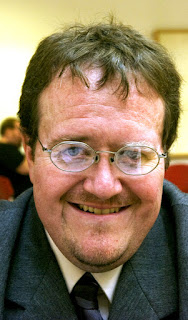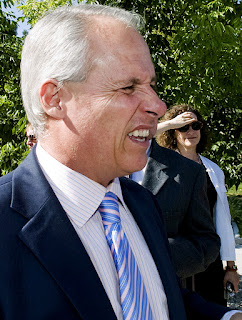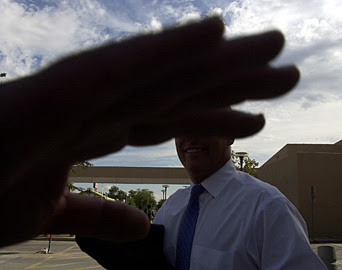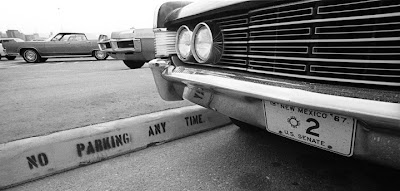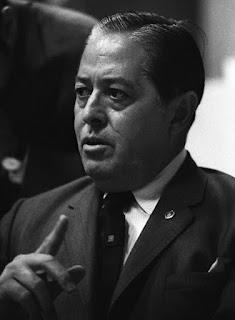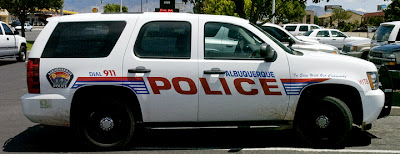What's wrong with this picture?
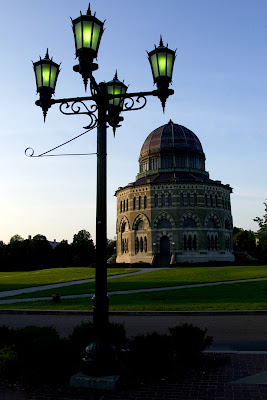
This is the Arthur Library at Union College in Schenectady, N.Y. It’s named after an 1848 graduate, Chester A. Arthur.
He’s probably the most famous graduate, but by no means the only famous graduate. Franklin D. Roosevelt’s father and Winston Churchill’s grandfather, 15 U.S. Senators, 91 members of the House of Representatives, seven cabinet secretaries, 13 Governors and numerous high ranking government officials, judges, missionaries, generals and 90 college presidents, also lay claim the Union as their alma mater, according to the college’s web page.
They forgot one; my friend Paul Livingston is also a graduate.
My father grew up in Schenectady. While in the Air Force, he was offered his choice of assignments; he chose his hometown, where he taught in the Reserve Officers’ Training Corps from 1956-59 at Union.
Arthur, a lawyer, was appointed by President U.S. Grant to be the Collector of the Port of New York in 1871. The customhouse was traditionally a corrupt enterprise. Though Arthur kept more employees than necessary, he managed to clean up the corruption.
Arthur was President James A. Garfield’s vice president. Both were reformers.
Charles Guiteau, a lawyer and disgruntled office-seeker, shot Garfield at a railway station in Washington on July 2, 1881. Garfield was incapacitated and though doctors attempted to locate the bullet, they did so with unwashed hands causing a massive infection. Garfield died of internal hemorrhaging on September 19, 1881.
During the time of Garfield’s convalescence, Arthur secluded himself and the presidency was adrift.
Arthur signed a piece of legislation that excluded paupers, criminals, and lunatics from the country in 1882. Shortly after, he was presented with the first immigration law called the Chinese Exclusion Act; Arthur signed it May 6, 1882. At least they were honest about their bigotry; it was the only race based immigration law. It was the first of a series of federal immigration laws, followed by the 1921 Emergency Quota Act and the Immigration Act of 1924.
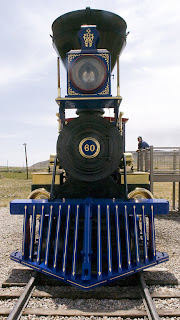
This is Jupiter, a replica of the Central Pacific Railroad's engine at the Golden Spike National Historic Site, at Promontory Point, Utah. This is where the east and west coasts were linked by rail on May 10, 1869. Chinese immigrant labor was used extensively on this branch of the railroad because white Californians were trying to hit Eureka in the gold fields.
The original Jupiter was manufactured at the Schenectady Works, which would later become the American Locomotive Company. Jupiter was placed on a ship, sailed through the straight of Magellan, at the southern end of South America to San Francisco and was the engine that delivered Central Pacific Railroad's President Leland Stanford, also then Governor of California, to the spike driving ceremony. Stanford was a native of Albany, N.Y., the next city southeast of Schenectady.
The American Locomotive Company is where my father worked, as a tank inspector, between the time he graduated college and joined the service at the beginning of World War II.
As a result of Garfield’s assassination, congress passed the Pendleton Act in 1883. It established a civil service process to replace the spoils system that had allowed for political supporters to be appointed to all jobs in the federal government. The Pendleton Act allowed for a very limited number of political appointees at the highest levels of the president's administration. The rest of the federal employees are retained based solely on professional performance and they may not engage in or be removed for political activity.
So what's wrong with this picture?
There is a screeching and howling going on over Mayor Martin Chávez and Police Chief Ray Schultz’ press conference this past week. They reaffirmed that the City of Albuquerque will not target people who might be in this country without proper documents.
It seems the reason for the press conference was that some officers were not following department policy that reflected the position of the city council. Keeping politics and personal beliefs out of officers’ decision making is one of the hardest things for police administrators to accomplish. On occasion, some officers reject the Standard Operating Procedures and substitute personal biases and political beliefs into their actions instead. When the clarification was announced, some officer(s) who disagreed with the city’s position, contacted the media and brought their disagreement onto the public stage. The news media, sensing a controversy, dutifully reported it. Therefore, a cat fight!
Several years ago, the city council passed a resolution unanimously establishing that any person seeking city services would not be denied based on their immigration status alone.
There is a great deal of confusion in this debate over the roles, duties and responsibilities of various law enforcement agencies. Misunderstanding, misinformation, wishful thinking, bias, prejudice, bigotry, racism and hatred all are in play in driving this debate.
Under the concept of federalism, the duties of the individual states and their political subdivisions to protect all persons within their boundaries are separate and distinct from the federal government.
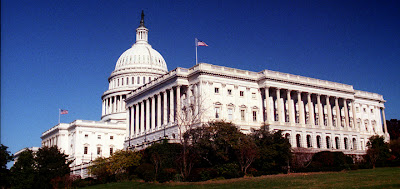
The federal government, through congress, writes laws that apply to everyone in the country. The president, through the executive branch, has the duty to enforce those laws.
Under our federalist form of government, states through their legislatures, also may write laws. They are enforced by the various governors executive branch’s enforcement agencies, including: state police, county sheriffs and municipal police departments.
So what’s different about state and local officers, as opposed to federal officers?
What is a cop? A cop is the conservator of peace and good order. Their job is to protect life and property. It’s an ancient calling. Over the years, a philosophy has developed, which is that all people are protected, treated the same and not subject to being bothered, questioned or harassed, unless there is probable cause to believe a crime has been committed and the offender is known.
Immigration has again become a hot button political issue. The events of 9-11 are used as a smokescreen to reinforce efforts at protecting our borders.
That duty is relegated to federal officers and is properly performed by border patrol, customs and immigration officials.

The City passed a resolution: “Opposing the Enactment of Federal Legislation Calling for State and Local Police to Enforce Federal Civil Immigration Laws,” on June 7, 2004, sponsored by then Councillor Eric Griego, left.
“Section 1. The City opposes the enactment of the CLEAR Act and HSEA and any other legislation encouraging or compelling local law enforcement to enforce federal civil immigration laws.
Section 2. The City reaffirms its commitment to civil rights and equal access to all city services including police protection regardless of immigration status.
Section 3. The City reaffirms that no municipal resources will be used to identify and apprehend persons solely based on their immigration status.”
The measure, which reaffirmed a 2001 position, passed 7-0-2, with council members: Griego, Michael Cadigan, Miguel Gómez, Debbie O'Malley, Martin Heinrich, Sally Mayer and Tina Cummins voting for, while Brad Winter and Craig Loy were excused.
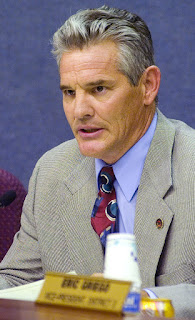
Winter, right, is currently proposing having a task-force look into the 2001 policy.
“We need to immediately clarify what city law requires of its local law enforcement, and then we need to take a look at the bigger picture,” Winter said in his press release. “We live in a border state in a post 9-11 world. The people of Albuquerque deserve input on how we deal with these issues.”
However, he disregards that the 2001 policy was reviewed in 2004 when he was excused. It raises the old quote, “The absent are always wrong.”
The Clear Law Enforcement for Criminal Alien Removal Act of 2003 (CLEAR Act) was introduced on July 9, 2003. It had over 100 co-sponsors but was soundly defeated as it was considered by opponents, “the wolf in sheep's clothing that this bill really was . . .,” according to the National Immigration Project of the National Lawyers Guild’s website. “The bill’s authors aggressively promoted it as an anti-crime measure, and exploited fears of terrorism to demand its enactment. House offices were blanketed almost daily with “Dear Colleague” letters from Representative Charlie Norwood R-Ga., and others, citing horrific crimes and prescribing the CLEAR Act as panacea.”
http://www.nationalimmigrationproject.org/LegalUpdates/CLEAR%20Update%20Dec04.htm
Senator Jeff Sessions, R-Ala., introduced a similar measure entitled the Homeland Security Enhancement Act of 2003 (HSEA) on November 20, 2003. It never gained any traction in the senate.
“The United States Conference of Mayors hereby urges Congress to amend the proposed Clear Act and Homeland Security Enhancement Act of 2003 to reflect our opposition to additional un-funded federal mandates, our opposition to distracting local and state law enforcement from their primary mission, and our concerns about potential undermining of previous federal legislation that protects immigrant victims,” was adopted as a resolution at the mayors’ annual meeting in Boston in 2004.
The International Association of Chiefs of Police opposed the passage of the legislation for a variety of reasons. They particularly pointed out that local law enforcement is not required to enforce the federal immigration laws; those duties properly reside with federal immigration officers, according to an IACP policy publication, “Enforcing Immigration Law: The Role of State, Tribal and Local Law Enforcement.”
http://www.theiacp.org/documents/pdfs/Publications/ImmigrationEnforcementconf%2Epdf
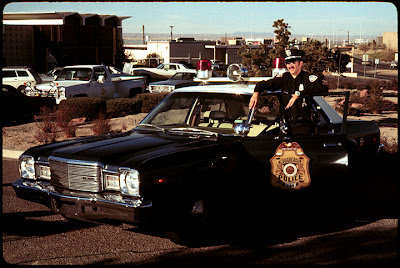
When I joined the Albuquerque Police Department in 1976, there were officers accepting under the table bounties of $25 for each “illegal alien” they turned over to the U.S. Immigration and Naturalization Service. This violated a couple sections of the standard operating procedures, specifically accepting rewards for doing your duty. However, it also violated a policy against rounding up people in the street who were not being charged with a criminal act. As far as I could tell, the practice subsided, or it might have just gone underground.
The EYE on Albuquerque and local talk radio’s Jim Villanucci of 770 – KKOB News Radio, have generated a fair amount of noise.
The EYE posted a purported excerpt of an INS and Federal Bureau of Investigation 2006 (First Quarter) Statistical Report on Undocumented Immigrants.
James Madison’s admonition, about what to do when confronted with offensive speech, echoes in my ears, “more speech, not less speech,” or censorship. I don’t buy the numbers for several reasons: the document does not read like a federal bureaucratic report normally reads, the numbers are so high that they defy logic and common reasoning, I could not locate the document or reference to it on the Department of Justice, Bureau of Justice Statistics, FBI or the Department of Homeland Security websites. INS no longer exists and hasn’t for more than four years. INS is now the U.S. Citizenship and Immigration Services, a division of the Department of Homeland Security.
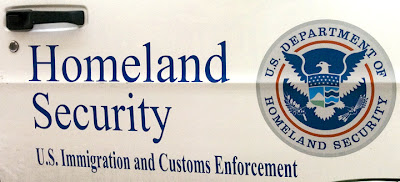
The EYE has been bamboozled and apparently unknowingly is attempting to hoodwink their readers by posting unverifiable information. I remind the EYE and others of the old phrase, used by the now defunct City News Bureau of Chicago, on fact checking; “If your mother tells you that she loves you, check it out!”
Let’s look at a few of the statements and see if we can debunk them.
The EYE posted the “Statistical Report on Undocumented Immigrants,” to complain about the APDs failure to ask for information on a person’s legal immigration status. No state or city police report has a check or explanation box documenting residency status. The FBI Uniform Crime Reports is the way that crime information is captured. Each state and every police department are required to send certain data to the FBI on a monthly basis for statistical analysis.
The claims of the “Statistical Report on Undocumented Immigrants,” can not be correct because there is no way to capture the raw data purportedly used.
The following, in particular, need thoughtful consideration:
Crime -- 86% of warrants for murder in Albuquerque are for illegal aliens.
Albuquerque’s murder clearance rate is very high. There are very few warrants issued for murder because arrests are made for suspects who are in custody for interrogation. The mainstream media extensively covers murders in town and there is no obvious trend in the immigration status of suspects and warrants issued; if there were, it probably would have been seized upon.
Traffic Violations -- 66% of cited/stopped drivers in New Mexico have no license, no insurance and no registration for the vehicle. Of that 66%, 98% are illegal aliens.
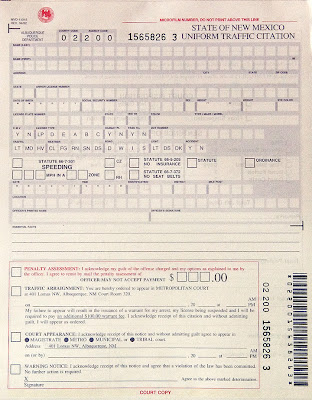
This is a State of New Mexico Uniform Traffic Citation. It’s the charging document used by all police officers when issuing traffic tickets.
The personal information obtained for a citation is: last name, first name, middle initial, address, city, state, zip code, license issuing state, license number, date of birth, social security number, sex, height, weight and eye color.
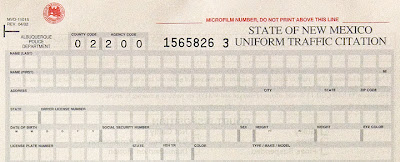
Nowhere on this document will you find race, ethnicity or nationality listed. The reason you don’t find it is because asking those questions are a violation of the person’s civil rights. Without that information, there is no way to generate the claim that illegal aliens were cited or especially stopped.
There is no reason to believe any of the numbers in this so-called “Statistical Report on Undocumented Immigrants.”
Villanucci claims that when he went on the air Aug. 14, he exposed a flaw in APD’s SOP section on Undocumented Foreign Nationals (Undocumented Immigrants) and that during his show received a new fax of the SOP with a change.
http://www.abqradio.com/770/770APDImmigrationStory.pdf
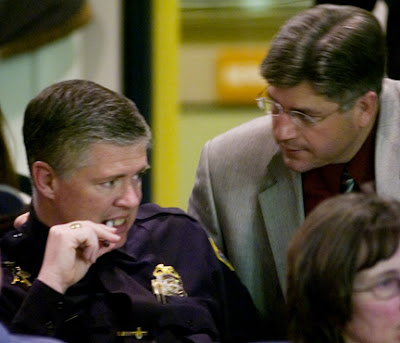
Villanucci called Schultz, left, and APD Public Information Officer John Walsh, right, liars.
It is unfortunate that Chávez, Schultz and Walsh engaged in “hot footing,” reacting wildly and thoughtlessly to volume rather than reason. The second fax, sent to Villanucci does not clarify, but undermines the role of local law enforcement, defies the council’s directive and makes matters worse. Police deal with state crimes, not federal immigration laws.
The clarification is actually meaningless because it is in direct conflict with the rest of the standard and the SOP shall not conflict with the council’s resolution.
One of the reasons that police officers do not try to ascertain nationality is, beyond the civil rights question, because everyone who is not obviously disobeying the law is presumed innocent and officers may not bother people based on their race, culture or even nationality.
It is a fundamental philosophy of policing that all people are protected equally, regardless of race, creed or color, as found in the fourteenth amendment.
If officers made presumptions about the legal status of individuals who sought their assistance, several things could and in some places have happened. People in need will not seek assistance. A criminal class will grow that preys upon those who fear the police. When crime occurs and they either happen within the fearful community or someone who fears the police is a witness or victim, they will not come forward and crime will run rampant.
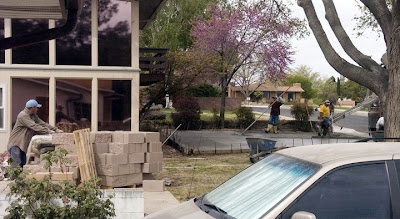
There is an argument that when certain people are arrested, that based on how they look, dress, speak, act or by the nature of the work they do, that an officer may presume that the person might be, either undocumented or otherwise violating conditions of immigration laws. A group of immigration law proponents argue that anyone who is arrested and appears to be undocumented, should be deported.
In the criminal justice system, this is not such a good idea, for at least a couple of reasons. Justice is not served by simply deporting an offender. What the system is saying is, “go away, you bother us.” Next stop, the big green bus for a ride south. The proper answer is to: prosecute, convict, sentence, serve, and then deport on the big green bus for a ride south.
There is a fair amount of evidence that people who are deported will make the effort to return to this country and many seem to succeed. The result is a de facto release from charges. If the person returns after being deported, little, if anything, will have changed; especially their criminal ways. They may also not be subjected to being charged again. It’s that nasty double jeopardy or statue of limitations thing.
For those who argue that undocumented people take all the benefits of this country, but don’t pay any taxes, it simply isn’t true. They pay taxes though their rent and in all commercial transactions where tax is an automatic add-on. Organizations that assist foreigners, like Catholic social services, recommend that undocumented workers get a social security number and pay both federal and state income taxes. The reasoning is multi-fold: it is the law, having a social security card allows one to get a job and paying taxes establishes a history of being in the country and acting as a responsible and serious person.
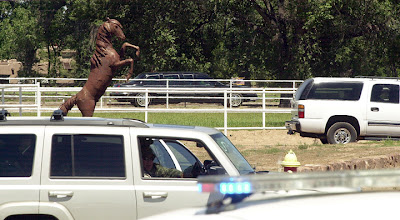 The president came and went.
The president came and went.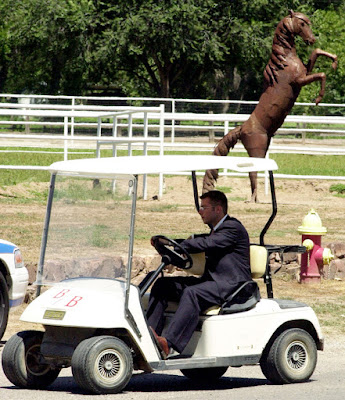 Over the years, the protection has gotten tighter and tighter. This is not a condemnation of how they do their work, for they have an incredibly difficult task.
Over the years, the protection has gotten tighter and tighter. This is not a condemnation of how they do their work, for they have an incredibly difficult task. Monday was no different. The local press sought shade during the waiting. They are: Journal's photographer Dean Hanson, foreground, KOAT's Matt Grubbs on his cellular phone, KRQE’s photojournalist Dominic Crespin, in the blue shirt, freelance photographer and KUNM radio reporter, Nick Layman, left, in the purple shirt and KOB’s News Chief Photographer Bazz McClain, partially hidden, with a lone protester, in the white shirt. Other members of the media included: the Journal’s Jeff Jones, Associated Press’ Melanie Dabovich and KOAT’s photojournalist Paul Hyso.
Monday was no different. The local press sought shade during the waiting. They are: Journal's photographer Dean Hanson, foreground, KOAT's Matt Grubbs on his cellular phone, KRQE’s photojournalist Dominic Crespin, in the blue shirt, freelance photographer and KUNM radio reporter, Nick Layman, left, in the purple shirt and KOB’s News Chief Photographer Bazz McClain, partially hidden, with a lone protester, in the white shirt. Other members of the media included: the Journal’s Jeff Jones, Associated Press’ Melanie Dabovich and KOAT’s photojournalist Paul Hyso.  First layer, Bernalillo County Sheriff's Traffic Sgt. J.P. Lazo, who with another officer, turned traffic around about a half mile south of the event on Rio Grande Boulevard.
First layer, Bernalillo County Sheriff's Traffic Sgt. J.P. Lazo, who with another officer, turned traffic around about a half mile south of the event on Rio Grande Boulevard.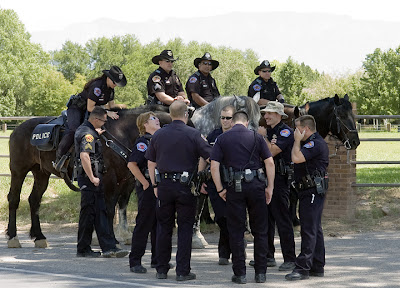 Second, members of the Albuquerque Police Department's horse mounted unit and emergency response team limit the northern most access for the public.
Second, members of the Albuquerque Police Department's horse mounted unit and emergency response team limit the northern most access for the public. The third and fourth levels are provided by members of the USSS uniform division in a grey sport utility vehicle, that ran a parallel path with the limousine, backed up by an APD special weapons and tactics unit in the white SUV, seen in the background of the first picture at the top of the post.
The third and fourth levels are provided by members of the USSS uniform division in a grey sport utility vehicle, that ran a parallel path with the limousine, backed up by an APD special weapons and tactics unit in the white SUV, seen in the background of the first picture at the top of the post.  Protesters were allowed closer, about 200 yards, than I have previously noticed. They were still out of shouting range, though the presidential limousine is little more than a bank safe on wheels and from within the hermetically sealed Cadillac, nothing probably can be heard.
Protesters were allowed closer, about 200 yards, than I have previously noticed. They were still out of shouting range, though the presidential limousine is little more than a bank safe on wheels and from within the hermetically sealed Cadillac, nothing probably can be heard.  Only moments before the limousine appeared on the driveway of Abraham’s estate, two American flags were hoisted across the road. What does that mean? Supporters were granted access while the news media, regular citizens, and sign carrying protesters were kept away. Is the president only allowed to see signs of support? Does that constitute an abridgment of the first amendment right to petition government for a redress of grievances?
Only moments before the limousine appeared on the driveway of Abraham’s estate, two American flags were hoisted across the road. What does that mean? Supporters were granted access while the news media, regular citizens, and sign carrying protesters were kept away. Is the president only allowed to see signs of support? Does that constitute an abridgment of the first amendment right to petition government for a redress of grievances? After completing the motorcade escort, APD Traffic Section Lt. Todd Parkins, right, and another officer wend their way towards the scene of the crash as vehicles at the Sunport are ensnarled.
After completing the motorcade escort, APD Traffic Section Lt. Todd Parkins, right, and another officer wend their way towards the scene of the crash as vehicles at the Sunport are ensnarled. 